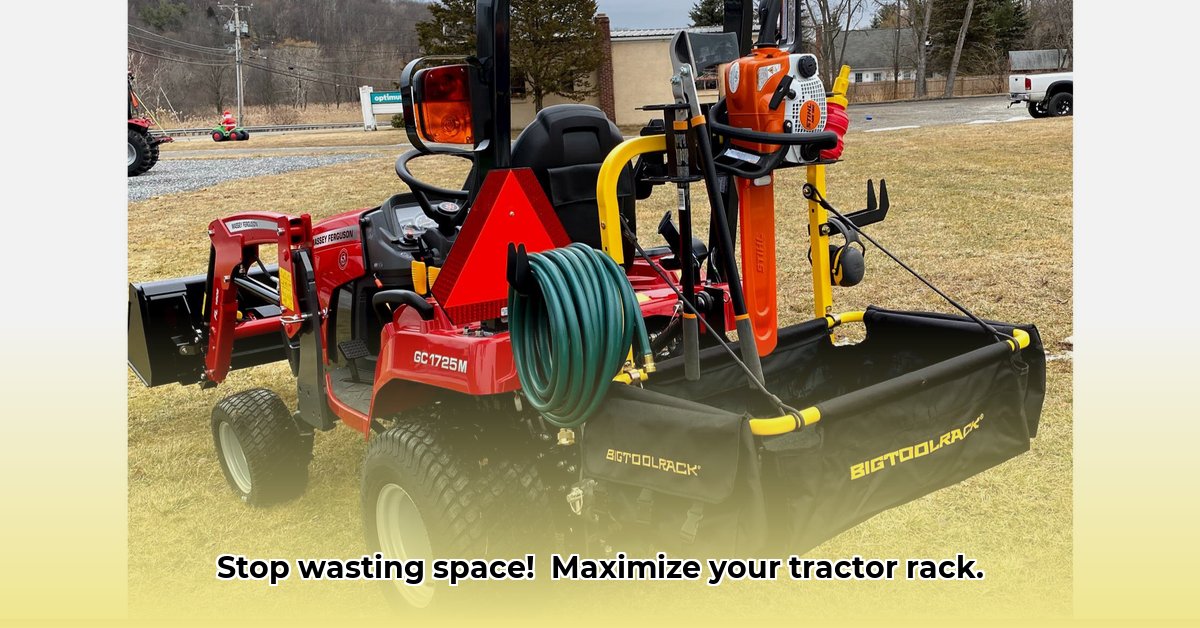
Tractor Racks: Streamlining Your Farm Operations
Choosing the right tractor rack can significantly impact your farm's efficiency. A well-organized setup means less time searching for tools and more time focused on productive work. But with so many options available, how do you choose the perfect rack for your needs? This guide provides a step-by-step approach to selecting and maintaining a high-performing tractor rack. Don't overlook the potential for improved efficiency; the right rack can be a game-changer. Isn't maximizing your time and resources a top priority for any successful farm? For smaller farms, consider used tractors.
Understanding Your Needs: The Foundation of a Successful Choice
Before you even begin browsing tractor racks, take stock of your current situation. What tools and equipment do you regularly transport? How much weight will the rack need to support? What's your budget? These questions are crucial for narrowing your options. A thorough assessment of your needs prevents purchasing a rack that's either too small or unnecessarily expensive. Think of it as planning the layout of a new barn - you wouldn't start building without a blueprint, would you?
Exploring Different Tractor Rack Types
The market offers a wide variety of tractor racks, each designed for specific tasks and environments. Here are a few common types:
- Rear-Mounted Racks: These are a popular choice, offering easy access to tools and excellent visibility of your load. However, excessive weight on the rear can affect the tractor's handling.
- Front-Mounted Racks: Convenient for quick access to frequently used tools, but heavy loads on the front can interfere with steering and maneuverability.
- Box Racks (Enclosed): These provide weather protection for your tools, particularly beneficial for delicate or sensitive equipment. They may offer slightly less accessibility than open racks.
- Open Racks: Simple, cost-effective, and offer easy access to tools. However, they don't provide protection from the elements.
- Custom-Built Racks: If your needs are highly specific, a custom-built rack offers the most tailored solution, perfectly matching your tractor and equipment. This option is often the priciest.
Choosing Your Tractor Rack: A Step-by-Step Guide
Selecting the perfect tractor rack isn't simply a matter of aesthetics; it's about safety and efficiency. Follow these steps to make an informed decision:
- Inventory Your Tools: Carefully list all tools and equipment you regularly transport, noting their dimensions and weight. This determines the required rack size and weight capacity.
- Measure Your Tractor: Accurate measurements are essential to guarantee a proper and secure fit. A poorly fitting rack is not only inefficient but also unsafe. Always consult your tractor's specifications.
- Material Selection: Consider whether steel's superior strength or aluminum's lighter weight and rust resistance best suits your needs and the type of tools you'll be carrying.
- Evaluate Mounting and Security: Opt for a rack with a simple, secure installation process and robust locking mechanisms to prevent tools from shifting or falling during transport.
- Prioritize Safety: A well-designed rack prioritizes the safety of both the operator and the equipment. Look for sturdy construction, secure mounting, and features that minimize the risk of accidents or damage.
- Compare Prices and Features: Don't solely focus on the initial cost. Consider durability, ease of use, and expected lifespan. A higher-quality rack may offer long-term savings through extended service life.
The Pros and Cons of Tractor Racks
While tractor racks offer many benefits, it's important to be aware of potential drawbacks.
| Feature | Advantages | Disadvantages |
|---|---|---|
| Efficiency | Significantly reduces search time and improves workflow | Initial investment cost |
| Organization | Keeps tools readily available and prevents damage. | May require careful planning to avoid clutter or overloading |
| Safety | Prevents tool loss and damage during transport | Improper installation can lead to safety hazards |
| Durability | High-quality racks are designed for longevity | Subject to wear and tear; regular maintenance is crucial |
| Accessibility | Tools are readily accessible where and when needed. | Increased tractor weight may slightly reduce fuel efficiency |
Maintaining Your Tractor Rack Investment
Regular inspection is critical for the longevity of your tractor rack. Check welds, bolts, and mounting points for signs of wear. Addressing minor issues promptly prevents costly repairs down the line. Think of it as preventative maintenance for your farming operation.
Key Considerations
- How to effectively integrate AI into existing small business operations (such as using AI to predict tool usage and optimize rack configuration) can greatly enhance efficiency.
- Regularly review your tool needs and adjust rack configuration as necessary. Your farming operation may evolve over time, necessitating changes to your rack setup.
A well-chosen and maintained tractor rack is a valuable investment, significantly improving your farm's operational efficiency, safety, and profitability. By following the advice outlined here, you can make an informed decision and reap numerous benefits for years to come.